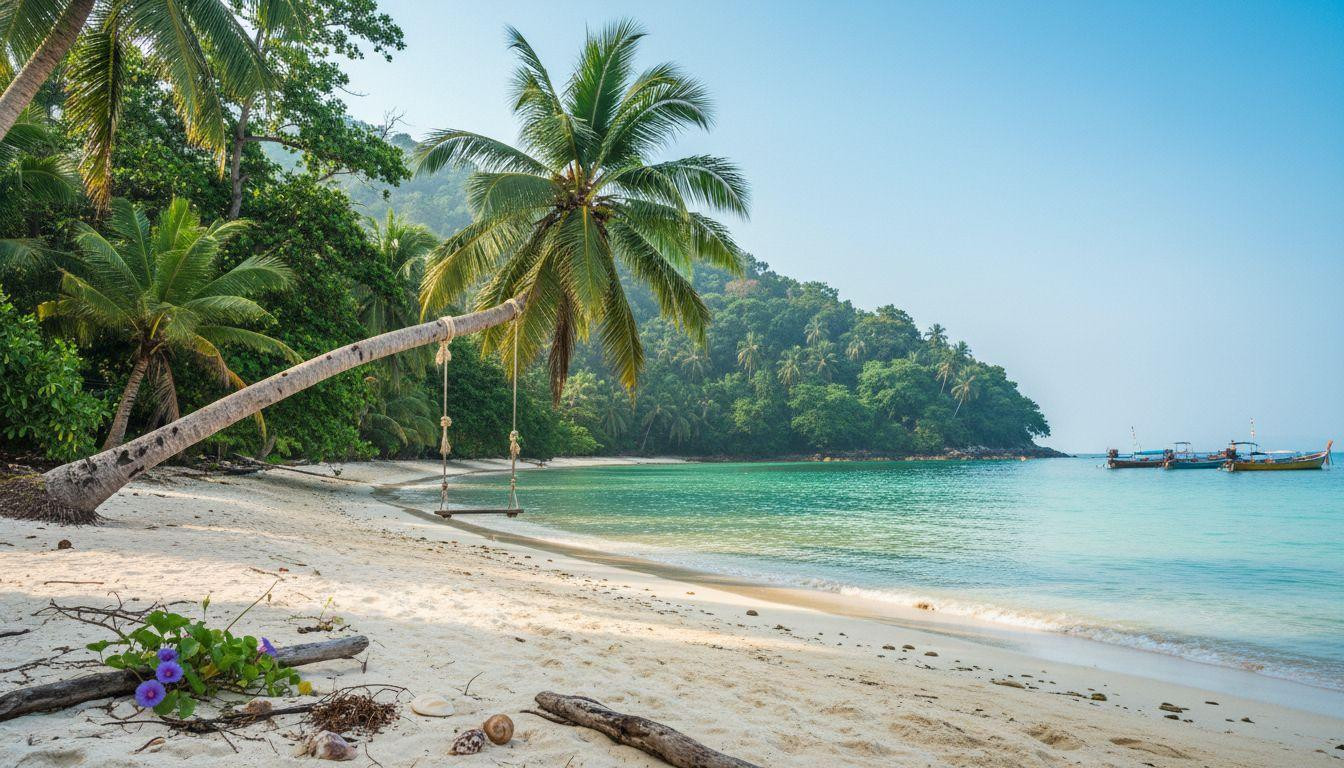Dawn breaks at 6:08 AM over Klong Chao Beach as morning light ignites white sand against impossible turquoise water. The iconic palm-tree swing hangs motionless in November stillness. This is Koh Kood, Thailand’s 4th-largest island, where 2,000 residents wake to fishing rhythms while Phuket’s millions sleep off another crowded sunset.
One hour by speedboat from Trat, six hours from Bangkok’s chaos, this temporal sanctuary preserves what Thai islands were before Instagram destroyed them. November 19, 2025 marks the perfect threshold: dry season begins, crowds remain minimal, and travel bloggers whisper urgently about visiting before it becomes too developed.
The island tourism forgot to commercialize
Koh Kood sits in eastern Thailand’s Gulf, south of Koh Chang, near the Cambodian border. While neighboring islands surrendered to development decades ago, this 4th-largest Thai island made a deliberate choice: preserve character over profit. The result feels surreal: an island where 2,000 people occupy two fishing villages (Ao Salad and Ao Yai), where no 7-Eleven exists, where the “main road” sees three scooters daily.
Resort development remains selective rather than comprehensive. November 2025 finds the island at a crossroads: new hotels appear periodically, yet the momentum of modern tourism has barely arrived. You’re witnessing the final window of a preserved era that rivals car-free islands in authenticity.
Where turquoise water meets untouched jungle
Visual perfection without the crowds
Koh Kood’s western beaches present an almost monotonous perfection: turquoise water, pristine white sand, and dense emerald vegetation extending to the shoreline. The visual palette remains remarkably uniform across 12 named beaches. Soft powder sand earns repeated descriptions as “the most beautiful I have seen in Thailand.”
Unlike developed Thai islands where beaches become cleared promenades, Koh Kood maintains embedded wilderness. Natural tree canopy provides shade along every beach. The disorienting emptiness strikes every visitor: most beaches remain empty of people, creating a cognitive challenge in experiencing an island where solitude remains default rather than exception.
The Instagram moment that didn’t ruin everything
Klong Chao Beach’s horizontal palm trees with suspended swing have generated social media visibility, yet somehow haven’t destroyed the island’s quietness. The free-admission Khlong Chao Waterfall, accessible via an 850-meter jungle trail requiring just 25 minutes hiking time, draws visitors into interior wilderness without commercialization. These photogenic elements exist but haven’t triggered the viral destruction cycle that consumed other tropical destinations.
Living on island time and island budget
The $25-50 daily reality
Comprehensive budget calculations reveal $25-50 covers reasonable daily travel: basic accommodation at family-run guesthouses ($20-50 nightly), local meals at food stalls ($1.50-3 per dish), and modest activities. Mid-range travelers budget $80-150 daily including comfortable resorts and restaurant dining. This compares favorably to developed Thai island destinations where similar experiences cost double.
The notable absence of processed foods and international chains forces engagement with genuine Thai cuisine. No McDonald’s, Starbucks, or packaged snacks exist. This refreshing but sometimes challenging reality pushes visitors toward authentic local food culture rather than familiar global options.
What you’ll actually do here
Kayaking emerges as the signature activity: a leisurely cruise through turquoise waters, moving from coast to coast differently than passive resort lounging. Kayak rentals cost $6-17 daily at operators like Kut Kayak. Snorkeling trips range $43-140 depending on sites visited and group size.
The waterfall experience provides escape to cascades in jungle with easy accessibility. Sunset watching becomes primary evening activity, creating magical tropical paradise moments that function as refuge from intense modern life. Similar island experiences elsewhere cost significantly more.
The fishing villages where real Thailand survives
Ao Salad and Ao Yai maintain active fishing communities forming the island’s social backbone. Working fishermen, traditional boats, and harbor scenes resemble Thailand’s coastal areas fifty years ago. Daily rhythms revolve around tidal patterns and seafood harvests rather than tourist schedules. Fishing boats depart at 4:30 AM and return with fresh catches at 10:00 AM and 4:00 PM.
Fresh catches appear daily at village markets: snapper, grouper, squid, prawns prepared via grilling, curry-based cooking, or som tam preparations. The absence of aggressive vendors, touts, and commercial pressure distinguishes Koh Kood culturally. Thai hospitality extends throughout, though service remains warm but unhurried, reflecting the island’s overall rhythm.
According to local tourism boards, the island deliberately chose preservation over maximizing profit. This restraint created a temporal oddity where Koh Kood functions as a preserved vision of what Thai island tourism might have looked like had it prioritized sustainability. Authentic destinations like this become increasingly rare.
Your Questions About Koh Kood Answered
When should I visit and how do I get there?
November 19, 2025 positions you at the optimal threshold: dry season begins, temperatures range 79-90°F, and tourist concentration remains minimal before December-February peak. From Bangkok, fly to Trat ($63, 45 minutes), then speedboat to island ($34, 75-90 minutes). Alternative budget route involves bus to Trat then ferries island-hopping via Koh Chang.
What makes this different from other Thai islands?
Koh Kood delivers what Phuket and Koh Samui lost: turquoise waters and white sand without crowds, commercialization, or infrastructure-as-spectacle. No jet ski rentals, parasailing, or high-activity entertainment exists. With only 100,000 annual visitors versus Phuket’s 10.3 million, the island explicitly serves those keeping backpacker crowds away while maintaining genuine budget options.
Is it really still undeveloped?
Recent visitor surveys show 40% year-over-year growth, yet the island maintains its character through development restrictions. Only 30% of land area can be developed, with 70% preserved as natural habitat. New boutique resorts appear each season, but coral health remains at 75% live coverage versus 20-30% in Koh Samui. You’re experiencing what overtourism destroyed elsewhere, before it’s gone here too.
Morning coffee steams in Ao Salad as fishing boats return with dawn catch. This island of 2,000 guards its temporal sanctuary jealously, yet new hotels appear each season. November 2025 offers the final perfect window: dry season calm, minimal crowds, authentic Thai island life before inevitable transformation begins.
